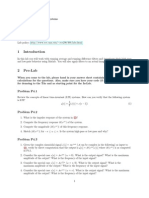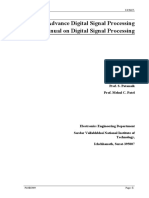Matlab Optimization
Matlab Optimization
Uploaded by
ela arasuCopyright:
Available Formats
Matlab Optimization
Matlab Optimization
Uploaded by
ela arasuOriginal Title
Copyright
Available Formats
Share this document
Did you find this document useful?
Is this content inappropriate?
Copyright:
Available Formats
Matlab Optimization
Matlab Optimization
Uploaded by
ela arasuCopyright:
Available Formats
Matlab Optimization
1. Optimization toolbox
2. Solution of linear programs
3. Metabolic flux balance analysis example
4. Solution of nonlinear programs
5. Batch fermentation example
Matlab Optimization Toolbox
Minimization
bintprog Solve binary integer programming problems
fgoalattain Solve multiobjective goal attainment problems
fminbnd Find minimum of single-variable function on fixed interval
fmincon Find minimum of constrained nonlinear multivariable function
fminimax Solve minimax constraint problem
fminsearch Find minimum of unconstrained multivariable function using derivative-free method
fminunc Find minimum of unconstrained multivariable function
fseminf Find minimum of semi-infinitely constrained multivariable nonlinear function
linprog Solve linear programming problems
quadprog Solve quadratic programming problems
Least Squares
lsqcurvefit Solve nonlinear curve-fitting (data-fitting) problems in least-squares sense
lsqlin Solve constrained linear least-squares problems
lsqnonlin Solve nonlinear least-squares (nonlinear data-fitting) problems
lsqnonneg Solve nonnegative least-squares constraint problem
Note: fsolve is also part of the optimization toolbox
Linear Programming (LP)
Optimization of a linear objective function with linear
equality and/or inequality constraints
Standard LP form:
Matrix A must have more columns than rows (under-
determined problem)
Common solvers: CPLEX, MOSEK, GLPK
Further information
0 x
b Ax
x c
x
>
= : subject to
min
T
http://www-unix.mcs.anl.gov/otc/Guide/faq/linear-programming-faq.html
x vector of variables to be determined (decision variables)
A matrix of known coefficients
b vector of known coefficients
c vector of weights
c
T
x scalar objective function; linear combination of the decision variables
Matlab LP Solver: linprog
Solves linear programming (LP) problems of the form:
Syntax:
x = linprog(f,A,b,Aeq,beq,lb,ub)
Set A=[]and b=[]if no inequality constraints exist
Set Aeq=[]and beq=[]if no equality constraints exist
Replace f with -f to find the maximum
Defaults to a large-scale interior point method with options for a
medium-scale simplex method variation or the simplex method
See help linprog for additional details and options
ub x lb
beq x Aeq
b x A
x f
T
x
s s
=
s : subject to
min
where f, x, b, beq, lb, and ub are vectors and A and Aeq are matrices
Metabolic Network Model
Intracellular reaction pathways describing carbon metabolism
Consumption of carbon energy sources (e.g. glucose)
Conversion of carbon sources to biomass precursors (cell growth)
Secretion of byproducts (e.g. ethanol)
Each node corresponds to a metabolite
Each path (line) corresponds to a reaction
Stoichiometric matrix, A
Row for each intracellular species (m rows)
Column for each reaction (n columns)
The entry at the i
th
row and j
th
column (a
i,j
) corresponds to the
stoichiometric coefficient of species i participating in reaction j
Av = 0, stoichiometric balance on the metabolites where v is the
vector of reaction fluxes
More reactions (unknowns) than species (equations)
Solution requires either enough measurements for the system to
become square (n-m measurements) or optimization
Flux Balance Analysis (FBA)
Linear programming (optimization) approach for resolving an under-
determined metabolic network model
Objective function based on an assumed cellular objective such as
maximization of growth
LP formulation:
Growth rate, , represented as a linear combination of intracellular
fluxes of the biomass precursors
Flux bounds represent physiochemical or thermodynamic constraints
on the reaction fluxes
Extracellular conditions place limits on fluxes (e.g. oxygen availability)
Thermodynamics constrain the direction a reaction may proceed:
reversible or irreversible
The solution is the set of fluxes that maximizes cellular growth while
satisfying the bounds and stoichiometric constraints
U L
T
v
v v v
Av
v w
s s
=
=
0 : subject to
max
Download the stoichiometric matrix to the
Matlab working directory and load into Matlab
>> load A.txt
Specify the indices of key fluxes: glucose,
ethanol, oxygen, and biomass
>> ig = 22; ie = 20;
>> io = 19; imu = 17;
Av = 0
>> [m n] = size(A);
>> b = zeros(m,1);
Objective function
>> w = zeros(n,1);
>> w(imu) = 1;
Specify flux bounds (all fluxes irreversible,
glucose uptake fixed)
>> vb = [zeros(n,1) Inf*ones(n,1)];
>> vb(ig,:) = [100 100];
Flux Balance Analysis Example
Yeast metabolic network model from HW #2
Slightly modified to improve suitability for Flux Balance Analysis
(FBA)
19x22 stoichiometric matrix
Under-determined with 3 degrees of freedom
Use FBA to determine solution corresponding to optimal cell growth
Solve the LP
>> v = linprog(-w,[],[],A,b,vb(:,1),vb(:,2));
Optimization terminated.
View predictions for growth, oxygen uptake, and ethanol
secretion
>> mu = w'*v, vo2 = v(io), ve = v(ie)
mu =
101.9302
vo2 =
108.3712
ve =
2.4147e-014
All calculated values relative to a fixed glucose uptake rate
normalized to 100%
FBA Example cont.
Determine sensitivity of model predictions to the oxygen uptake
rate to assess the tradeoff between achievable ethanol yields and
cellular growth
Create a vector of oxygen uptake rates to be considered
>> vo = 1:1:125;
Implement a for loop to iterate over each entry in the oxygen
uptake vector (vo). For each iteration (inside the loop), update
the upper bound* on oxygen uptake, solve the LP, and store the
solution (mu, ve)
>> for i=1:length(vo)
vb(io,2) = vo(i);
v = linprog(-w,[],[],A,b,vb(:,1),vb(:,2));
mu(i) = w'*v;
ve(i) = v(ie);
end
Plot the results
>> plot(vo,mu,vo,ve);
>> xlabel('Oxygen Flux')
>> legend('Growth Rate','Ethanol Flux)
Notice the tradeoff between cell growth and ethanol production.
Highest ethanol productivity is achieved in batch fermentation
by initially operating aerobically to rapidly increase cell density
then switching to anaerobic conditions to produce ethanol.
*A fixed oxygen uptake rate (lower bound equal to upper bound) was not specified to avoid forcing the cell to
take up more oxygen than necessary (cell should only use as much oxygen as it needs).
Nonlinear Programming (NLP)
Optimization of a nonlinear objective function with
nonlinear equality and/or inequality constraints
Standard NLP form:
System must have more variables than equality constraints
(under-determined problem)
Common solvers: CONOPT, NPSOL
Non-convex problems can converge to a local optimum
x vector of variables to be determined (decision variables)
h(x) vector function of equality constraints
g(x) vector function of inequality constraints
f(x) scalar objective function
0 x g
0 x h
x
x
s
=
) (
) (
: subject to
) ( min f
Nonlinear least-squares: lsqnonlin
x = lsqnonlin(@fun,x0,lb,ub)
where fun is a user-defined function that returns the vector value F(x),
x0 is the initial guess (starting point), and lb and ub are the bounds on x
Constrained nonlinear multivariable optimization : fmincon
where x, b, beq, lb, and ub are vectors, A and Aeq are matrices, c(x)
and ceq(x) are functions that return vectors, and f(x) is a function that
returns a scalar
x = fmincon(@fun,x0,A,b,Aeq,beq,lb,ub,@cfun)
where fun is the function for f(x) and cfun is a function that returns c(x) and ceq(x)
f = fun(x) [c,ceq] = cfun(x)
Matlab NLP Solvers: lsqnonlin and fmincon
ub x lb
beq x Aeq
b x A
x ceq
x c
x f
x
s s
=
s
=
s
0 ) (
0 ) ( : s.t.
) ( min
2 2
3
2
2
1
2
1
2
) ( ) ( ) ( ) ( ) ( min x f x f x f x f x f
n
n
i
i
x
+ + + + =
=
(
(
(
(
=
) (
) (
) (
) (
) (
3
2
1
x f
x f
x f
x f
x F
n
Batch Fermentation Example
Parameter estimation problem for penicillin fermentation
Model equations
Batch cell growth is modeled by the logistic law
where y
1
is the cell concentration, k
1
is the growth constant & k
2
is the
cessation (limiting nutrient) constant
Penicillin production is modeled as
where y
2
is the penicillin concentration, k
3
is the production constant &
k
4
is the degradation (hydrolysis) constant
Dynamic parameter estimation
Use experimental data from two batch penicillin fermentations
Find values for the unknown parameters (k
1
, k
2
, k
3
, k
4
) that minimize the
sum of squared errors between the data & model predictions
|
|
.
|
\
|
=
2
1
1 1
1
1
k
y
y k
dt
dy
2 4 1 3
2
y k y k
dt
dy
=
Matlab Exercise: Batch Data Sets
Cell Penicillin Cell Penicillin
Time concentration concentration concentration concentration
(hours) (% dry weight) (units/mL) (% dry weight) (units/mL)
0 0.4 0 0.18 0
10 0 0.12 0
22 0.99 0.0089 0.48 0.0089
34 0.0732 1.46 0.0642
46 1.95 0.1446 1.56 0.2266
58 0.523 1.73 0.4373
70 2.52 0.6854 1.99 0.6943
82 1.2566 2.62 1.2459
94 3.09 1.6118 2.88 1.4315
106 1.8243 3.43 2.0402
118 4.06 2.217 3.37 1.9278
130 2.2758 3.92 2.1848
142 4.48 2.8096 3.96 2.4204
154 2.6846 3.58 2.4615
166 4.25 2.8738 3.58 2.283
178 2.8345 3.34 2.7078
190 4.36 2.8828 3.47 2.6542
Batch 1 Batch 2
Load & plot the experimental data:
Choose an initial guess, integrate the model, & plot the simulated profiles:
Estimate parameter values that minimize the sum of squared errors between
the experimental measurements & model predictions:
Matlab Exercise: Solution
>> pendat = xlsread('penicillin.xls');
>> tdat = pendat(:,1);
>> ydat = pendat(:,2:end);
>> plot(tdat,ydat,'o');
>> xlabel('Time [h]');
>> ylabel('Concentration');
>> k0 = [0.1 4 0.01 0.01];
>> y0 = [0.29 0];
>> ts = [min(tdat) max(tdat)];
>> dy = @(t,y,k) [k(1)*y(1)*(1-y(1)/k(2)); k(3)*y(1)-k(4)*y(2)];
>> [tsim,ysim] = ode45(dy,ts,y0,[],k0);
>> hold on, plot(tsim,ysim,':');
>> options = optimset('Display','iter');
>> k = lsqnonlin(@simerr,k0,[],[],options,dy,ts,y0,tdat,ydat);
>> [tsim,ysim] = ode45(dy,ts,y0,[],k);
>> plot(tsim,ysim);
Matlab Exercise: simerr.m
function e = simerr(k0,dy,ts,y0,tdat,ydat)
% Integrate the model
sol = ode45(dy,ts,y0,[],k0);
% Evaluate solution at the data points
y = deval(sol,tdat)';
% Error between data and model
e = ydat - y;
% Find missing measurements
n = find(isnan(ydat));
% Zero error for missing measurements
if ~isempty(n)
e(n) = zeros(size(n));
end
You might also like
- Answer Key Sample Paper 1 AI Class 10 TutorialaicsipDocument11 pagesAnswer Key Sample Paper 1 AI Class 10 TutorialaicsipAmar AryanNo ratings yet
- Tot Ship F Uel Z 1Document4 pagesTot Ship F Uel Z 1hhhhhhhhhhhhhhhhNo ratings yet
- ISTQB Questions by ChaptersDocument103 pagesISTQB Questions by ChaptersMirka Ivanova0% (1)
- MATLAB Optimization ToolboxDocument37 pagesMATLAB Optimization Toolboxkushkhanna06No ratings yet
- An Introduction To An Introduction To Optimization Optimization Using Using Evolutionary Algorithms Evolutionary AlgorithmsDocument45 pagesAn Introduction To An Introduction To Optimization Optimization Using Using Evolutionary Algorithms Evolutionary AlgorithmsSai Naga Sri HarshaNo ratings yet
- Tankov2 PDFDocument101 pagesTankov2 PDFcmehmetNo ratings yet
- Exam Pan American Advanced Studies Institute Program On Process Systems EngineeringDocument26 pagesExam Pan American Advanced Studies Institute Program On Process Systems EngineeringRashadafaneh0% (1)
- A Computational Comparison of Two Different Approaches To Solve The Multi-Area Optimal Power FlowDocument4 pagesA Computational Comparison of Two Different Approaches To Solve The Multi-Area Optimal Power FlowFlores JesusNo ratings yet
- Financial Modeling With Levy ProcessesDocument101 pagesFinancial Modeling With Levy ProcessesBranden KeckNo ratings yet
- SOT MethodDocument9 pagesSOT Methoduazeez478No ratings yet
- 07a80805 OptimizationofchemicalprocessesDocument8 pages07a80805 OptimizationofchemicalprocessesSharanya ThirichinapalliNo ratings yet
- Matlab Lect SPDocument6 pagesMatlab Lect SPparultNo ratings yet
- Ada RGPV Chatgpt QuesDocument32 pagesAda RGPV Chatgpt QuesSangeeta Gupta 8bNo ratings yet
- Linear Control Systems Lab (EE3302) : E X Per I M E NT NO: 1Document19 pagesLinear Control Systems Lab (EE3302) : E X Per I M E NT NO: 1Syed Shehryar Ali NaqviNo ratings yet
- 02 Huong DanDocument37 pages02 Huong Dankhanhvo070373No ratings yet
- Prob 5 5Document6 pagesProb 5 5rodrigo_0909No ratings yet
- An Improved Bilevel Evolutionary Algorithm Based On Quadratic ApproximationsDocument15 pagesAn Improved Bilevel Evolutionary Algorithm Based On Quadratic ApproximationsDilan SahinNo ratings yet
- Week 1Document6 pagesWeek 1Muhammed Razi MNo ratings yet
- Nonlinear SystemsDocument14 pagesNonlinear SystemsRasheed KibriaNo ratings yet
- Ex 2 SolutionDocument13 pagesEx 2 SolutionMian AlmasNo ratings yet
- Ga-MatlabDocument19 pagesGa-MatlabMaham AkramNo ratings yet
- EigenvaloptDocument13 pagesEigenvaloptSáng QuangNo ratings yet
- Questions 3Document5 pagesQuestions 3Ramon AberionNo ratings yet
- Scientific Computing: Optimization Toolbox Nonlinear Equations, Numerical OptimizationDocument45 pagesScientific Computing: Optimization Toolbox Nonlinear Equations, Numerical OptimizationmortezagashtiNo ratings yet
- SDFGBNDocument16 pagesSDFGBN0721673895No ratings yet
- Different Simplex MethodsDocument7 pagesDifferent Simplex MethodsdaselknamNo ratings yet
- Research Paper 3Document4 pagesResearch Paper 3SAMPATH ANo ratings yet
- Expt 02 DSP LabDocument10 pagesExpt 02 DSP Labproddut ChakrabortyNo ratings yet
- Linear Control Systems Lab: E X Per I M E NT NO: 1Document17 pagesLinear Control Systems Lab: E X Per I M E NT NO: 1Syed Shehryar Ali NaqviNo ratings yet
- IE684 Lab05Document3 pagesIE684 Lab05Tirthankar AdhikariNo ratings yet
- Tut7 QuestionsDocument2 pagesTut7 QuestionsAmir SharifiNo ratings yet
- Module-1 DSDV NotesDocument13 pagesModule-1 DSDV NotesAnanya A MNo ratings yet
- Han LMI Struct Linear Cdc03Document6 pagesHan LMI Struct Linear Cdc03Tensegrity WikiNo ratings yet
- NLPQLY: An Easy-To-Use Fortran Implementation of A Sequential Quadratic Programming Algorithm - User's GuideDocument11 pagesNLPQLY: An Easy-To-Use Fortran Implementation of A Sequential Quadratic Programming Algorithm - User's Guideatmane1984No ratings yet
- Project 1Document11 pagesProject 1Ahmed AbdelhalimNo ratings yet
- Particle Swarm Optimization: Algorithm and Its Codes in MATLABDocument11 pagesParticle Swarm Optimization: Algorithm and Its Codes in MATLABSaurav NandaNo ratings yet
- Matlab Review PDFDocument19 pagesMatlab Review PDFMian HusnainNo ratings yet
- Ex Day6Document6 pagesEx Day6retokoller44No ratings yet
- FminconDocument3 pagesFminconБогдан КулиничNo ratings yet
- Lab 05Document4 pagesLab 05kamranjavNo ratings yet
- Assn 2Document3 pagesAssn 2●●●●●●●1No ratings yet
- Efficient Solution of Multiple-Model, Multiple-Algorithm Problems in Undergraduate and Graduate EducationDocument24 pagesEfficient Solution of Multiple-Model, Multiple-Algorithm Problems in Undergraduate and Graduate EducationAzar DeenNo ratings yet
- Output Linear Feedback For A Class of Nonlinear Systems Based On The Invariant Ellipsoid MethodDocument6 pagesOutput Linear Feedback For A Class of Nonlinear Systems Based On The Invariant Ellipsoid MethodinfodotzNo ratings yet
- F09 E6 CB0 D 01Document10 pagesF09 E6 CB0 D 01Laxmansarat KondepudiNo ratings yet
- IE684 Lab03Document6 pagesIE684 Lab03Tirthankar AdhikariNo ratings yet
- Practice 6 8Document12 pagesPractice 6 8Marisnelvys CabrejaNo ratings yet
- Digital Signal Processing - Exercises: 1 Sequences and SystemsDocument7 pagesDigital Signal Processing - Exercises: 1 Sequences and SystemsAsia YasirNo ratings yet
- Tut Number MatlabDocument2 pagesTut Number MatlabAnas FoulNo ratings yet
- EC106 Advance Digital Signal Processing Lab Manual On Digital Signal ProcessingDocument69 pagesEC106 Advance Digital Signal Processing Lab Manual On Digital Signal ProcessingSHARAD FADADU0% (1)
- FiltersDocument5 pagesFiltersfamtaluNo ratings yet
- BG2801 - L3 Solution of Roots of EquationsDocument9 pagesBG2801 - L3 Solution of Roots of EquationsSnehal BhadaniNo ratings yet
- Practical Lesson 4. Constrained Optimization: Degree in Data ScienceDocument6 pagesPractical Lesson 4. Constrained Optimization: Degree in Data ScienceIvan AlexandrovNo ratings yet
- Cientific Omputing: Fusen LinDocument16 pagesCientific Omputing: Fusen LinDana MckenzieNo ratings yet
- Introduction To Matlab: By: Kichun Lee Industrial Engineering, Hanyang UniversityDocument34 pagesIntroduction To Matlab: By: Kichun Lee Industrial Engineering, Hanyang UniversityEvans Krypton SowahNo ratings yet
- Application of The NPGA To The Design of Power Distribution SystemsDocument5 pagesApplication of The NPGA To The Design of Power Distribution SystemsItalo ChiarellaNo ratings yet
- UntitledDocument5 pagesUntitledVivek Kumar TrivediNo ratings yet
- Linear Programming - FormulationDocument27 pagesLinear Programming - FormulationTunisha BhadauriaNo ratings yet
- Chap 4Document9 pagesChap 4kadivar001No ratings yet
- Non-Monotone Submodular Maximization Under Matroid and Knapsack ConstraintsDocument20 pagesNon-Monotone Submodular Maximization Under Matroid and Knapsack ConstraintsednarofiNo ratings yet
- DSP Laboratory Guide 20feb2012Document44 pagesDSP Laboratory Guide 20feb2012anamaria_budaNo ratings yet
- CS Manual PDFDocument9 pagesCS Manual PDFrishitej811No ratings yet
- Problem 2Document1 pageProblem 2ela arasuNo ratings yet
- Problem 1Document1 pageProblem 1ela arasuNo ratings yet
- Relative Acidity Measurement of Bronsted Acid Functional Ionic Liquids by UV-spectrosDocument8 pagesRelative Acidity Measurement of Bronsted Acid Functional Ionic Liquids by UV-spectrosela arasuNo ratings yet
- What Is Your Rasi - Rasi and Nakshatra Calculator. NAKSHATRA TEMPLES. Find Out Your Raasi, Nakshatram Pada (Quarter) - BIRTH STADocument17 pagesWhat Is Your Rasi - Rasi and Nakshatra Calculator. NAKSHATRA TEMPLES. Find Out Your Raasi, Nakshatram Pada (Quarter) - BIRTH STAela arasuNo ratings yet
- Ethics PaperDocument1 pageEthics Paperela arasuNo ratings yet
- 7 Clean Architecture Patterns Practices Principles m7 SlidesDocument35 pages7 Clean Architecture Patterns Practices Principles m7 SlidesKim LongNo ratings yet
- 6012 - Creating UPSC FormsDocument36 pages6012 - Creating UPSC FormsDivy singhvi67% (3)
- Resume SubbarajuDocument3 pagesResume SubbarajusilverbyteNo ratings yet
- MIS Foundational ConceptsDocument22 pagesMIS Foundational Conceptssheenu117No ratings yet
- Internship Report: Meta-Learning Algorithms For Few-Shot Computer VisionDocument35 pagesInternship Report: Meta-Learning Algorithms For Few-Shot Computer VisionSwati VermaNo ratings yet
- A Teaching Laboratory For Process ControlDocument6 pagesA Teaching Laboratory For Process Controlahmed ubeedNo ratings yet
- Leadership ResponsibilitiesDocument1 pageLeadership ResponsibilitiesKNo ratings yet
- RCASEDocument3 pagesRCASEwatson191No ratings yet
- XRY Agile TestingDocument24 pagesXRY Agile TestingAnwarNo ratings yet
- Japanese Total Quality Control, TQM, Deming's System of Profound Knowledge, BPR, Lean and Six Sigma Comparison and Discussion 20401461111189425Document26 pagesJapanese Total Quality Control, TQM, Deming's System of Profound Knowledge, BPR, Lean and Six Sigma Comparison and Discussion 20401461111189425HafeezAbdullahNo ratings yet
- Double Well PotentialDocument6 pagesDouble Well PotentialBosonUpNo ratings yet
- Its Int.: H. in N. An ofDocument5 pagesIts Int.: H. in N. An ofRony Figueiredo SousaNo ratings yet
- RNN and LSTMDocument15 pagesRNN and LSTMShreyas VaradkarNo ratings yet
- Software Lifecycle ModelsDocument38 pagesSoftware Lifecycle ModelsNithish BabuNo ratings yet
- Agent-Based Simulation: Principles of Simulation and The Multi-Agent ApproachDocument42 pagesAgent-Based Simulation: Principles of Simulation and The Multi-Agent ApproachtuanngthanhNo ratings yet
- PMP Class - 2Document12 pagesPMP Class - 2Mahesh Chandra DixitNo ratings yet
- Triptico de Artificial IntelligenceDocument2 pagesTriptico de Artificial IntelligenceHappy.. GirlNo ratings yet
- TOGAF - Open Business Architecture (O-BA) - Part IIDocument43 pagesTOGAF - Open Business Architecture (O-BA) - Part IIvincentB100% (1)
- Springer Handbook of Robotics: January 2008Document5 pagesSpringer Handbook of Robotics: January 2008Rizwan ShaikhNo ratings yet
- DocDocument35 pagesDocSumaNo ratings yet
- Lead LagDocument5 pagesLead LagsreekanthaNo ratings yet
- Testing: Software Engineering Sommerville - Chapter 4,27 and 28Document29 pagesTesting: Software Engineering Sommerville - Chapter 4,27 and 28VCRajanNo ratings yet
- Fujipress - JRM 29 1 4Document13 pagesFujipress - JRM 29 1 4RezwanNo ratings yet
- AI Project (Group - 2)Document12 pagesAI Project (Group - 2)sumitq498No ratings yet
- New Advances in Machine LearningDocument374 pagesNew Advances in Machine LearningMücahid CandanNo ratings yet
- Testing - FoundationDocument111 pagesTesting - FoundationIoana BalazsNo ratings yet
- Subjects You Need To Know:: Programming Languages of AIDocument7 pagesSubjects You Need To Know:: Programming Languages of AIMaxSteel0% (1)
- Standard OperationsDocument25 pagesStandard OperationsfoofoolNo ratings yet






























































































